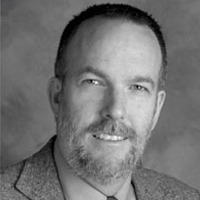Your excellent question can't be answered with just one sentence. There are many ways of producing acceptable black and white prints from color negatives. This is especially true with the advent of digital.
How to turn a color negative into a black and white print using wet process (conventional) printing.
- The easiest way (not the best) is to use standard black and white enlarging paper. However standard black and white printing papers are insensitive to red/orange; this insensitivity to red/orange will cause red's, yellow's and orange's (like skin tones) to be reproduced as dark and gray. If this grayness can be accepted then standard black and white papers can be used; however when printing a higher than normal contrast filter will most likely be needed, grade 3 or 4. A better method is needed.
- Kodak makes a paper called Panalure (soon to be discontinued) that is sensitive to all colors of light; Panalure is designed to be printed with color negatives. Normal black and white papers aren't sensitive to red/orange; this insensitivity to red creates the very gray dark red tones. Panalure is sensitive to all colors; because of this all colors in the original negative will be reproduced with the correct gray tone rendering. Because Panalure is sensitive to all colors it must be handled in total darkness - no safelight. Another benefit of using Panalure is colored black and white camera filters (red #25, yellow #8 etc.) can be used while printing. Place the color negative in the enlarger - place a #25 red filter under the enlarger lens - when this is done the original blue sky in the color negative will print much darker in the B&W print than normal. This is the same thought process as when shooting black and white film with the #25 red filter. Kodak has a Panalure publication #G-27 describing this paper. The following is a link to the G-27 publication-
How to turn a color negative into a B&W print using digital equipment.
- Digital is also a very appropriate method for making black and white prints from color negatives. Locate a film scanner - scan the color negative as a black and white negative or convert the color negative scan to a grayscale image in an imaging editing program like Photoshop. Make sure to scan your negative at the correct resolution. All digital files need to be at 300 dots per inch (DPI) at output size; this assumes the file will be printed to an inkjet print. Some scanners do the resolution math for you. Look at your scanner driver window (the window that opens when you open the scanner) - look for a document size/output size window - if the scanner has one enter the output size (lets say 8" x 10") - then look for a resolution or DPI window - enter 300. The scanner will do the math so the final 8" x 10" print is scanned at 300 dpi. A black and white negative scanned to 8" x 10" at 300 dpi will be about 7 megabytes, a color negative scanned in color will be about 20 megabytes in size.
- If your scanner doesn't do the math (no place to input the output size) then use the following formula- Output size (desired final print size) divided by input size (your original negative size) equals a scanning factor - multiply 300 dpi by the scanning factor - scan at the final number derived by the formula. Example 4" x 5" original print - an 8" x 10" print is desired - divide 10" by 5" which equals 2. Two is the scanning factor - multiply 300 dpi by 2 which equals 600 - scan the 4" x 5" print at 600 dpi. When the 5" print is resized to 10" in Photoshop the 600 dpi will fall to 300 dpi. 300 dpi is exactly the resolution an inkjet printer wants. If a 35mm negative is being scanned then divide 10" (the desired print size length) by 1.5" (the 35mm negatives approximate length) - 10 divided by 1.5 = 6.67 (6.67 = the scanning factor) - multiply 300 (dpi) by 6.67 which = 2001 - scan at 2000 dpi. When the 35mm negative is enlarged in Photoshop or another image editing program the 2000 dpi will fall to 300 dpi which is exactly what an inkjet printer needs.
- All of the above assumes you are starting with a color negative. Starting with the original negative will always give the best quality. If the original negative is not available then a copy negative or digital scan is the only other answer. If producing a copy negative then place the original print on a copy stand. If you don't have a copy stand then tape the print to an outside wall that is in the shade. Lighting the print with open shade is the easiest way to evenly light a small print without using copy stand lighting. Place your camera on a tripod - put black and white film in the camera (Freestyle 35mm 100.edu ultra 100 asa/iso would be a perfect film. - fill your camera frame with the print - use your internal camera meter for the exposure. If your normal lens won't focus close enough to fill the camera frame then try a longer lens further away. If the longer lens doesn't fill the camera frame then borrow a lens that will focus close (macro lens). Extension tubes or diopters will also work. Diopters are nothing more than a magnifying glass that looks like a clear screw-in filter. Diopters can be purchased from Freestyle to fit most any camera. This set will fit a lens that takes a 52mm filter. Order the proper set to fit your lens.
Hope this answers your question.


